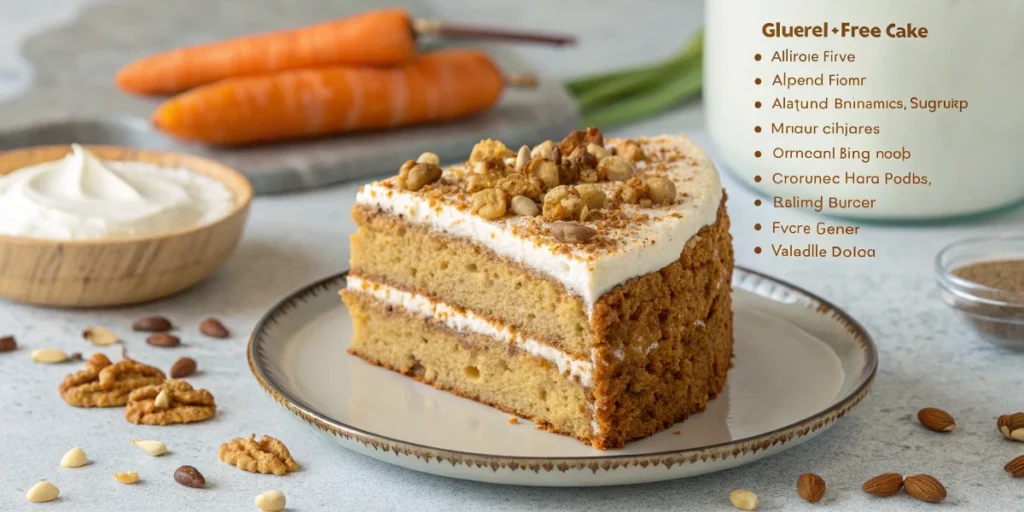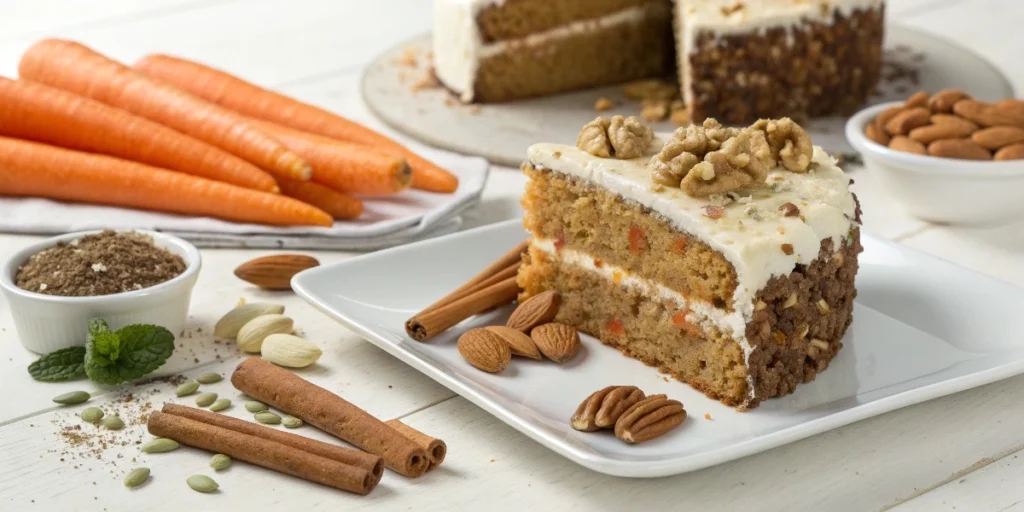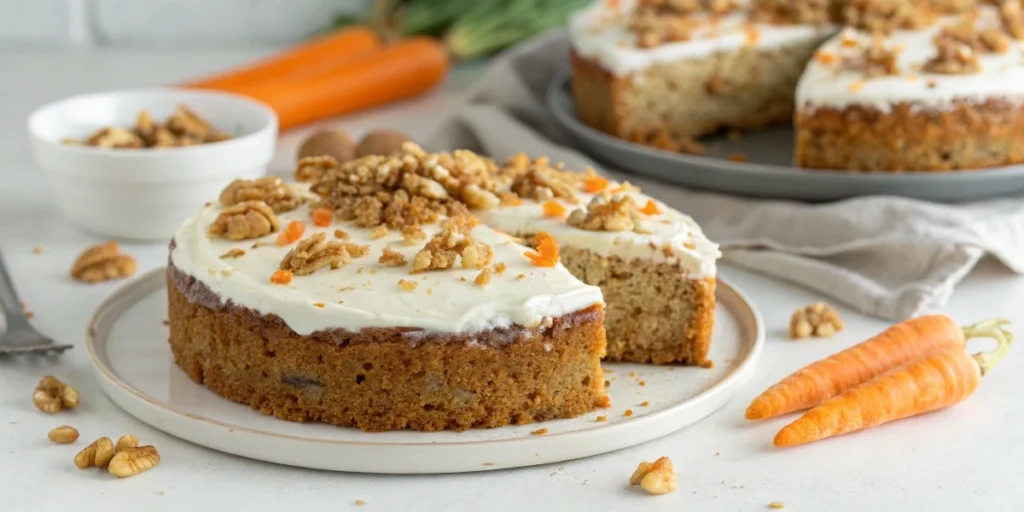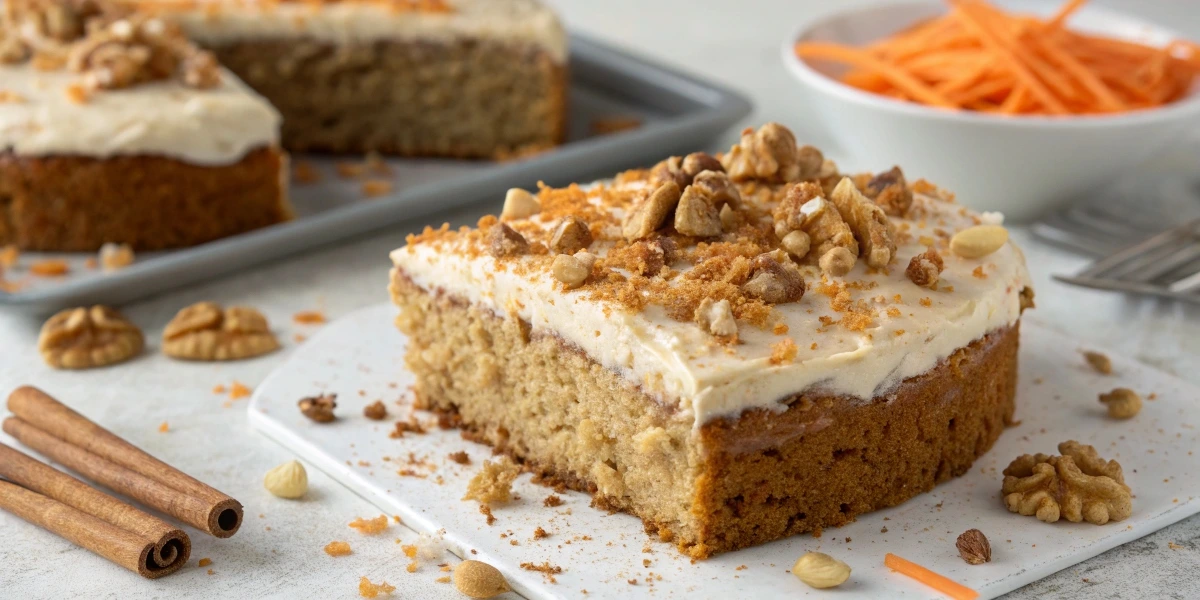Introduction: Can a Gluten-Free Carrot Cake Be Just as Delicious as the Original?
Have you ever wondered if a gluten-free version of carrot cake can be just as moist, flavorful, and satisfying as the traditional one? If you’ve been avoiding gluten but are craving a slice of cake, we have great news for you! A gluten-free carrot cake with almond flour may just be your new favorite treat. But how can almond flour, instead of regular wheat flour, make such a big difference? Keep reading to find out how you can make this naturally gluten-free, healthy twist on a classic dessert without sacrificing any of the taste.
Table of Contents
Overview: What Makes This Gluten-Free Carrot Cake with Almond Flour Special?
This gluten-free carrot cake with almond flour is a fantastic option for those who want to enjoy a delicious and healthier dessert. Whether you’re avoiding gluten due to dietary restrictions, or simply looking for an alternative, almond flour serves as a wonderful substitute for traditional flour in this recipe. It’s full of flavor, naturally grain-free, and surprisingly light—perfect for both special occasions and casual snacking!
Time and Difficulty Level:
- Prep Time: 15 minutes
- Cook Time: 40-45 minutes
- Total Time: 1 hour
- Difficulty Level: Easy to moderate (this cake is simple to make, but requires some care to ensure the texture and moisture are perfect)
The best part? This recipe is quick to make and only requires a few simple steps, but the result is a stunning dessert that everyone will love. You don’t need to be an expert baker to impress your friends and family with this flavorful, wholesome cake.
Essential Ingredients: What You Need and Why They Matter?

For this gluten-free carrot cake with almond flour, each ingredient plays a key role in achieving the best texture and flavor. Here’s a rundown of the essentials and why they’re so important:
1. Almond Flour (the star of the show!)
- Why it’s important: Almond flour is the primary ingredient that makes this cake gluten-free. It has a subtle, nutty flavor that pairs beautifully with the sweetness of the carrots. Almond flour is also denser than wheat flour, which gives the cake a moist, tender crumb without being heavy.
- Alternative: If you don’t have almond flour, you can use other gluten-free flours like coconut flour or a gluten-free all-purpose blend, but the texture might differ.
2. Carrots
- Why they’re important: Fresh, grated carrots add moisture, flavor, and nutrition to the cake. They also provide natural sweetness and a lovely color. Plus, carrots are full of fiber and beta-carotene, a form of vitamin A.
- Alternative: You can use zucchini instead of carrots for a different flavor and texture, but it will affect the cake’s overall taste.
3. Eggs
- Why they’re important: Eggs are the binding agent that helps hold the cake together. They also contribute to the cake’s lightness and structure.
- Alternative: For a vegan option, you can substitute eggs with flax eggs (1 tablespoon of ground flax seeds mixed with 3 tablespoons of water per egg).
4. Baking Powder
- Why it’s important: Gluten-free flours need a little extra lift to achieve a light texture. Baking powder helps the cake rise and gives it that fluffy, airy feel.
- Alternative: You can also use baking soda, but ensure there is enough acid (like lemon juice or vinegar) in the recipe to activate it.
5. Honey or Maple Syrup
- Why it’s important: Natural sweeteners like honey or maple syrup add a rich sweetness to the cake. They also help retain moisture, which is key in a gluten-free dessert.
- Alternative: You can use coconut sugar or agave syrup, but the taste will vary slightly.
6. Spices (Cinnamon, Nutmeg, and Ginger)
- Why they’re important: These warm spices add depth and complexity to the cake’s flavor, giving it that comforting carrot cake taste we all love. Cinnamon, in particular, pairs wonderfully with carrots.
- Alternative: You can experiment with other spices like allspice or cloves, but keep in mind that it may change the overall flavor profile.
7. Olive Oil or Coconut Oil
- Why it’s important: Healthy fats like olive oil or coconut oil provide moisture, richness, and a soft texture. They also contribute to the cake’s flavor.
- Alternative: You can use avocado oil or melted butter, but the cake may have a different texture or flavor.
8. Vanilla Extract
- Why it’s important: This adds a sweet, aromatic flavor that enhances the overall taste of the cake.
- Alternative: If you don’t have vanilla extract, you can use almond extract for a nuttier twist.
Step-by-Step Instructions: How to Make Gluten-Free Carrot Cake with Almond Flour?

Now that we’ve covered the essentials, let’s dive into the fun part: making the gluten-free carrot cake with almond flour! Here’s a simple, step-by-step guide to help you bake the perfect cake.
Step 1: Preheat and Prepare
Preheat your oven to 350°F (175°C). Grease and line an 8-inch round cake pan with parchment paper. This ensures the cake doesn’t stick and allows for easy removal after baking.
Step 2: Mix Wet Ingredients
In a large bowl, whisk together:
- 4 large eggs
- 1/2 cup of honey or maple syrup
- 1/2 cup of olive oil or melted coconut oil
- 2 teaspoons of vanilla extract
Whisk until the mixture is smooth and well combined.
Step 3: Add Dry Ingredients
In a separate bowl, combine the dry ingredients:
- 2 cups of almond flour
- 1 1/2 teaspoons of baking powder
- 1 1/2 teaspoons of ground cinnamon
- 1/2 teaspoon of ground nutmeg
- 1/4 teaspoon of ground ginger
- A pinch of salt
Mix these dry ingredients well before adding them to the wet mixture.
Step 4: Fold in the Carrots
Grate 2 cups of fresh carrots (about 3 medium-sized carrots). Gently fold them into the batter. You should have a thick, slightly lumpy batter.
Step 5: Pour and Bake
Pour the batter into your prepared cake pan. Smooth the top with a spatula. Bake for 40-45 minutes, or until a toothpick inserted into the center comes out clean.
Step 6: Cool and Frost (Optional)
Allow the cake to cool in the pan for 10 minutes before transferring it to a wire rack to cool completely. Once cooled, you can frost it with a cream cheese frosting or enjoy it as-is for a lighter option.
Assembly: Putting It All Together
Assembling your gluten-free carrot cake with almond flour is as easy as 1-2-3:
- Once the cake is fully cooled, spread your favorite frosting (cream cheese frosting is the classic choice) generously on top.
- You can also sprinkle some chopped walnuts or shredded coconut for extra texture and flavor.
- For a fancy touch, decorate the cake with additional grated carrots or edible flowers.
This cake is not just tasty but also visually appealing. It will be the star of any gathering!
Storage and Makeup Tips
Storing Leftovers:
- Store any leftover gluten-free carrot cake with almond flour in an airtight container at room temperature for up to 3 days. If you live in a hot climate, refrigerating it may be necessary.
- For longer storage, you can freeze the cake. Wrap it tightly in plastic wrap and aluminum foil, and store it in the freezer for up to 2 months. Thaw in the fridge overnight before serving.
Reheating Tips:
- To reheat, simply slice and microwave for 20-30 seconds, or warm in the oven at 350°F (175°C) for 5-10 minutes until heated through.
Recipe Variations: Get Creative with Your Cake

While this gluten-free carrot cake with almond flour is amazing as is, you can switch things up based on your preferences. Here are a few creative variations to try:
- Add-ins: Try adding chopped walnuts, raisins, or shredded coconut to the batter for extra texture and flavor.
- Spice it up: Experiment with additional spices like cardamom or allspice for a unique twist.
- Vegan version: Replace the eggs with flax eggs and the honey with maple syrup for a completely vegan-friendly carrot cake.
Conclusion: Try This Gluten-Free Carrot Cake with Almond Flour Today!
This gluten-free carrot cake with almond flour is a perfect balance of healthy ingredients and mouthwatering flavor. It’s a great option for anyone avoiding gluten or simply looking for a lighter dessert without compromising on taste. It’s easy to make, packed with flavor, and even more fun to enjoy with friends and family.
So, what are you waiting for? Grab your ingredients and get baking! You’ll be amazed at how satisfying this healthier version of carrot cake can be.
FAQs: Everything You Need to Know
Can I use regular flour instead of almond flour?
If you’re not following a gluten-free diet, you can use regular flour, but it will change the texture and make the cake denser. Almond flour provides a unique moistness and richness.
Is almond flour cake healthier than traditional carrot cake?
Yes! Almond flour is lower in carbs, higher in protein, and contains healthy fats compared to regular flour. It’s a great choice for those on a low-carb or gluten-free diet.
How long can I store this cake?
You can store the cake at room temperature for up to 3 days or in the fridge for up to a week. If freezing, wrap the cake tightly and store for up to 2 months.
Can I make this recipe ahead of time?
Absolutely! This cake actually improves in flavor after a day or two. You can bake it in advance and store it in the fridge until you’re ready to serve.
Enjoy your gluten-free carrot cake with almond flour and savor every bite!
If you’re looking to infuse your home or office with authentic North African charm, look no further than Artisanat Marrakech Maroc . Their curated collection showcases the finest in traditional Moroccan craftsmanship, from handwoven Berber carpets and intricately carved cedarwood doors to elegant copper and silver ceiling hangings. Whether you’re decorating a living room, bedroom, garden, or workspace, you’ll find unique pieces like leather poufs, engraved wooden tables, and Fassi tile fountains that bring timeless beauty and cultural richness to any space. Explore the full range of handcrafted treasures at Artisanat Marrakech Maroc Store and discover something truly special for your next interior design project.

Gluten-Free Carrot Cake Recipe with Almond Flour
Ingredients
Notes
Step-by-Step
Step 1: Preheat the Oven
- Preheat your oven to 350°F (175°C) .
- Line an 8-inch round springform pan or loaf pan with parchment paper.
Step 2: Mix Dry Ingredients
- In a medium bowl, whisk together:
- Almond flour
- Baking soda
- Salt
- Cinnamon
- Nutmeg
- Ginger (if using)
Step 3: Mix Wet Ingredients
- In a separate bowl, combine:
- Eggs
- Melted coconut oil
- Maple syrup (or honey)
- Vanilla extract
- Whisk until fully combined and slightly frothy.
Step 4: Combine Wet & Dry Ingredients
- Add dry ingredients to wet ingredients and mix well until no lumps remain.
Step 5: Add Grated Carrots and Optional Add-ins
- Stir in grated carrots, nuts, and raisins (if using).
- Mix until evenly incorporated.
Step 6: Pour into Pan and Bake
- Pour batter into the prepared pan and smooth the top with a spatula.
- Bake for 25–30 minutes , or until a toothpick inserted in the center comes out clean.
Step 7: Cool Completely
- Let the cake cool completely on a wire rack before adding frosting. This prevents melting.
Step 8: Make the Frosting (Optional)
- Beat softened cream cheese with powdered sweetener and vanilla until smooth.
- Add a splash of heavy cream or coconut cream if too thick.
- Spread over cooled cake.
Step 9: Slice and Serve
- Cut into slices and enjoy! Store leftovers in the fridge for up to 4 days or freeze for longer storage.
